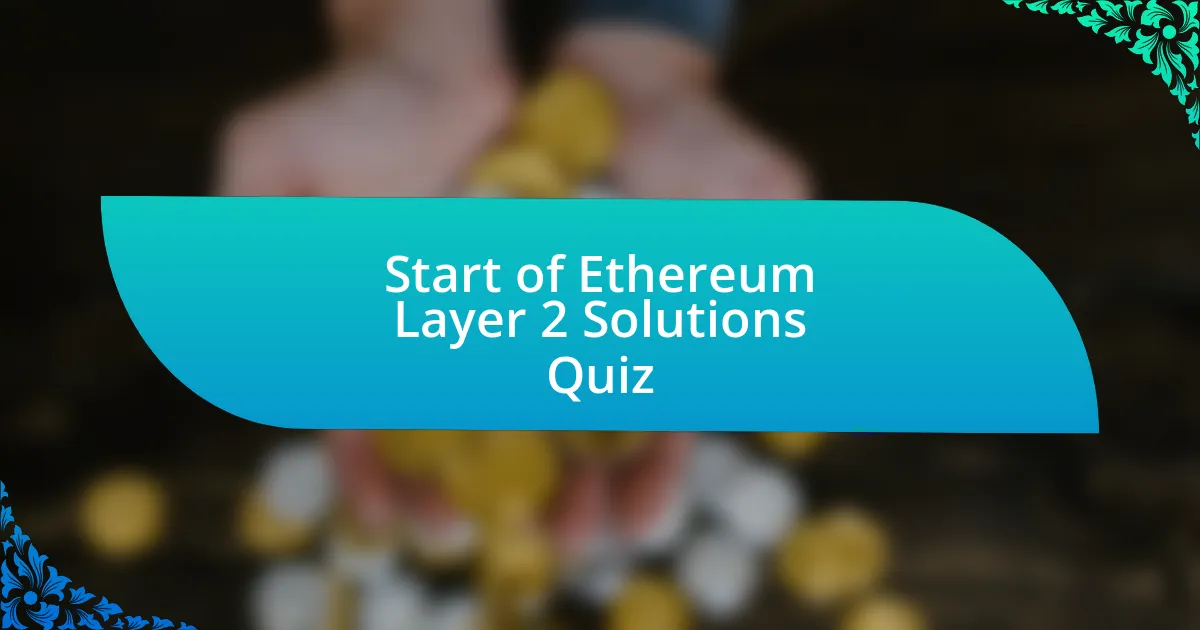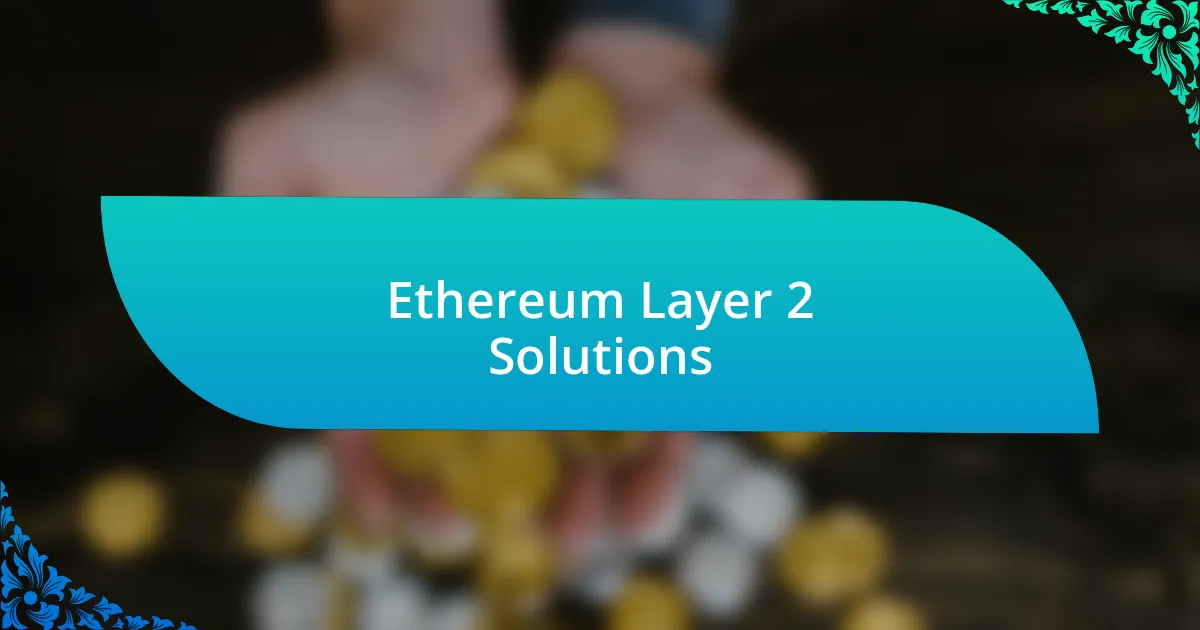
Start of Ethereum Layer 2 Solutions Quiz
1. What are the main goals of Ethereum Layer 2 solutions?
- To create a new cryptocurrency separate from Ethereum.
- To switch the Ethereum blockchain to a proof-of-stake consensus mechanism.
- To increase the maximum block size of the Ethereum blockchain.
- To significantly reduce transaction costs and improve transaction throughput.
2. How do Zero-Knowledge Rollups differ from Optimistic Rollups in terms of validation?
- Optimistic Rollups validate transactions using random sampling methods.
- Zero-Knowledge Rollups use cryptographic proofs for transaction validation.
- Optimistic Rollups require on-chain verification of all transactions.
- Zero-Knowledge Rollups rely completely on user honesty for validation.
3. What is the significance of Ethereum’s state channel technology?
- They have no impact on transaction speeds.
- They enable faster transactions and reduce fees.
- They prevent all transaction fees entirely.
- They only work for a single type of transaction.
4. Why is the concept of consensus important in Layer 2 solutions?
- It ensures all participants agree on transaction validity and state updates.
- It reduces the importance of the main Ethereum network.
- It eliminates the need for smart contracts entirely.
- It guarantees instant transaction confirmation without verification.
5. What challenges do Layer 2 solutions face in the Ethereum ecosystem?
- Liquidity fragmentation
- Centralized governance
- Limited application support
- Increased transaction fees
6. What role does the Arbitrum Layer 2 solution play in enhancing Ethereum’s capabilities?
- It introduces new consensus algorithms for Ethereum.
- It creates a separate blockchain to replace Ethereum.
- It increases the block size of Ethereum`s main chain.
- It improves transaction speeds and reduces fees for Ethereum.
7. How does the economic model of Layer 2 solutions benefit users?
- They significantly reduce transaction costs and improve transaction throughput.
- They eliminate the need for cryptocurrency entirely.
- They restrict the use of decentralized applications only.
- They solely increase transaction fees for all users.
8. What impact do Layer 2 solutions have on transaction fees compared to Layer 1?
- They have no effect on transaction fees.
- They increase transaction fees significantly.
- They double the transaction fees.
- They significantly reduce transaction fees.
9. How does batching transactions in Layer 2 solutions improve efficiency?
- By making all transactions mandatory on the main chain.
- By increasing the number of miners on the main chain.
- By slowing down the transaction processing speed.
- By processing transactions off-chain and then batching them for main chain settlement.
10. What is the importance of custody models in Layer 2 scaling solutions?
- They eliminate the need for any on-chain interactions.
- They increase network congestion and slow down transactions.
- They facilitate efficient transaction verification and reconciliation.
- They are not relevant to the scalability of blockchain solutions.
11. How do Layer 2 solutions promote interoperability within the Ethereum network?
- By offloading transactions to secondary networks, enabling faster communication.
- By processing all transactions directly on the Ethereum main chain only.
- By limiting transaction types to small amounts to reduce strain.
- By creating separate blockchains that do not interact with Ethereum.
12. What future trends are expected for Ethereum Layer 2 technologies?
- They will only be used for gaming purposes and have no impact on finance or other sectors.
- They are expected to fade away as new technologies emerge that replace blockchain-based systems.
- They will continue to play a pivotal role in facilitating wider adoption and unlocking the full potential of decentralized applications, enabling scalable, secure, and user-friendly experiences.
- They will limit the capabilities of decentralized applications by enforcing strict regulations.
13. How can developers leverage Layer 2 solutions to enhance decentralized applications?
- By storing all user data directly on the main blockchain for transparency.
- By centralizing transactions to a single server for faster processing.
- By requiring all transactions to be processed on the Ethereum mainnet only.
- By offloading transactions from the main blockchain to secondary networks, enhancing speed and reducing costs.
14. What is the role of Layer 2 solutions in facilitating cross-chain transactions?
- They force all transactions onto the main chain, causing delays and higher fees.
- They eliminate the need for any blockchain technology, operating independently.
- They only support transactions within a single blockchain without cross-chain capabilities.
- They enable faster and cheaper cross-chain transactions by processing off-chain and settling on the main chain.
15. How does Layer 2 technology contribute to Ethereum`s long-term sustainability?
- They require users to pay higher gas fees.
- They completely replace the Ethereum blockchain.
- They eliminate the need for smart contracts.
- They reduce gas fees and increase transaction speed.
16. In what ways do Layer 2 solutions improve user privacy?
- By making all transaction data accessible to anyone at any time.
- By utilizing zero-knowledge proofs to enhance transaction privacy for users.
- By consolidating all transactions into a single public record.
- By eliminating the need for any blockchain verification process.
17. What potential do Layer 2 solutions hold for non-fungible tokens (NFTs)?
- They eliminate the need for any form of decentralization in blockchain transactions.
- They increase the complexity of smart contracts and block validation.
- They are solely focused on enhancing the mining process of cryptocurrencies.
- They provide a scalable infrastructure for seamless in-game transactions and reduce the cost of minting and trading NFTs.
18. How do Layer 2 solutions manage security vulnerabilities?
- By relying on the security of Layer 1 and implementing additional validation mechanisms.
- By processing all transactions directly on Layer 2 without further checks.
- By decentralizing security protocols and removing the need for Layer 1.
- By using only external audits to validate transactions.
19. What is the relationship between Layer 2 solutions and Ethereum upgrades like ETH 2.0?
- Layer 2 solutions replace Ethereum entirely with a new blockchain.
- Layer 2 solutions enhance Ethereum`s scalability and efficiency.
- Layer 2 solutions only involve cosmetic changes to Ethereum`s user interface.
- Layer 2 solutions prevent any upgrades to the Ethereum network.
20. How do liquidity pools function in the context of Layer 2 solutions?
- Liquidity pools function by storing digital assets on centralized exchanges for trading.
- Liquidity pools are isolated accounts for individual users to manage their assets.
- Liquidity pools aggregate assets in a smart contract, allowing users to trade against the pool`s liquidity.
- Liquidity pools operate as traditional bank accounts, holding funds for withdrawals.
21. What are the developer tools available for building on Layer 2?
- Optimistic Rollups
- Smart Contracts
- Public Ledger Systems
- Centralized Databases
22. How do Layer 2 solutions influence the growth of decentralized finance (DeFi)?
- They enhance the scalability and usability of DeFi applications, allowing for faster and cheaper transactions.
- They solely increase the transaction fees associated with DeFi activities.
- They replace the need for traditional banking systems completely.
- They eliminate all risks associated with DeFi transactions.
23. In what scenarios are Layer 2 solutions particularly advantageous?
- When the network is underutilized
- When the blockchain is fully decentralized
- When there is high transaction volume on the Ethereum network
- When all transactions are simple and low-cost
24. How does user engagement change with the implementation of Layer 2 solutions?
- User engagement decreases as fewer transactions are processed.
- User engagement increases significantly due to lower fees and faster transactions.
- User engagement is negatively impacted by higher transaction costs.
- User engagement remains unchanged regardless of the changes made.
25. What is the significance of reducing on-chain data storage in Layer 2?
- It improves transaction efficiency and lowers costs.
- It creates new types of cryptocurrencies.
- It requires more user intervention for transactions.
- It increases the amount of data on the blockchain.
26. How can smart contract functionality expand with Layer 2 solutions?
- By introducing new programming languages for smart contracts.
- By reducing the number of nodes in the Ethereum network.
- By increasing the block size of the Ethereum main chain.
- By processing transactions off-chain for faster execution.
27. What elements contribute to the adoption of Layer 2 networks by developers?
- Increased complexity and security risks
- Centralized control and high transaction costs
- Limited scalability and network congestion
- Developer-friendly APIs and reduced transaction fees
28. How do Layer 2 solutions affect the overall Ethereum user base?
- Layer 2 solutions decrease the Ethereum user base by introducing new fees.
- Layer 2 solutions enhance the Ethereum user base by improving transaction speeds and reducing costs.
- Layer 2 solutions limit the Ethereum user base by creating more complex transactions.
- Layer 2 solutions isolate the Ethereum user base by moving all operations off-chain.
29. What technological advancements could further optimize Layer 2 solutions?
- Implementation of zk-rollups
- Downgrading the main chain security
- Eliminating gas fees completely
- Increasing the block size
30. How do Layer 2 solutions enhance transaction speeds compared to traditional methods?
- By introducing new consensus mechanisms that process transactions faster.
- By using more powerful computers to process transactions directly on the main chain.
- By increasing block size on the main chain, allowing more transactions per block.
- By handling transactions off the main chain to reduce congestion and speed up processing.

Quiz Completed Successfully!
Congratulations on completing the quiz about Ethereum Layer 2 Solutions! We hope you found it both informative and engaging. Throughout the quiz, you’ve had the chance to test your knowledge about key concepts, benefits, and challenges associated with Layer 2 technology. Understanding these ideas is essential as Ethereum continues to evolve.
Many of you might have discovered how Layer 2 solutions can enhance scalability and reduce transaction costs on the Ethereum network. These innovations are crucial for the future of decentralized applications and the broader blockchain ecosystem. You’ve also likely learned about various types of Layer 2 solutions, such as rollups and state channels, and how they serve different use-cases.
If you’re eager to delve deeper into Ethereum Layer 2 Solutions, we invite you to check out the next section on this page. It offers comprehensive insights and resources that can further expand your understanding. Continued learning will empower you to navigate the evolving landscape of Ethereum with confidence.

Ethereum Layer 2 Solutions
Overview of Ethereum Layer 2 Solutions
Ethereum Layer 2 solutions are protocols that operate on top of the Ethereum blockchain. They aim to enhance scalability and reduce transaction fees while maintaining security. These solutions facilitate faster transactions by processing them off the main Ethereum chain. They ensure user interactions with decentralized applications (dApps) remain efficient and cost-effective. By offloading transactions from the primary chain, Layer 2 solutions alleviate congestion on the Ethereum network.
Types of Ethereum Layer 2 Solutions
Ethereum Layer 2 solutions can be categorized primarily into rollups and state channels. Rollups bundle multiple transactions into a single one, reducing the load on the main chain. They include two main types: Optimistic Rollups, which assume transaction validity, and Zero-Knowledge Rollups, which use cryptographic proofs to verify transactions. State channels allow participants to transact off-chain, only settling the final state on the Ethereum chain. Each type serves specific use cases and improves overall transaction throughput.
Benefits of Using Ethereum Layer 2 Solutions
The primary benefits of Ethereum Layer 2 solutions include significantly lower transaction fees and improved scalability. Users experience faster transaction confirmations, as many Layer 2 protocols can handle thousands of transactions per second. These solutions enhance the user experience by making dApps more accessible and reducing costs. Furthermore, Layer 2 solutions help maintain Ethereum’s security through cryptographic proofs, ensuring that off-chain transactions do not compromise the main network.
Popular Ethereum Layer 2 Solutions
Several Ethereum Layer 2 solutions have gained prominence, including Polygon, Arbitrum, and Optimism. Polygon offers a framework for building and connecting Ethereum-compatible blockchain networks. Arbitrum utilizes Optimistic Rollups to enable fast and low-cost transactions. Optimism also focuses on reducing fees and increasing the scalability of Ethereum by leveraging Optimistic Rollups. Each of these solutions addresses unique challenges while enhancing the Ethereum ecosystem.
Future Developments in Ethereum Layer 2 Solutions
The future of Ethereum Layer 2 solutions looks promising, with ongoing advancements aimed at improving interoperability and user experience. Developers are exploring enhanced tools for cross-chain compatibility and integration with Ethereum’s upcoming upgrades. Continued investment in research and development will likely lead to more innovative solutions that further increase scalability while ensuring security. As adoption grows, these technologies will play a key role in the evolving landscape of decentralized finance.
What are Ethereum Layer 2 Solutions?
Ethereum Layer 2 Solutions are protocols built on top of the Ethereum blockchain to enhance its scalability and efficiency. They achieve this by processing transactions off the main Ethereum chain while still benefiting from its security. Examples include Optimistic Rollups and zk-Rollups, which can significantly increase transaction throughput and reduce fees. Layer 2 solutions are crucial for addressing Ethereum’s current limitations related to high gas fees and network congestion.
How do Ethereum Layer 2 Solutions work?
Ethereum Layer 2 Solutions work by taking transactions off the main blockchain (Layer 1) and processing them on a secondary framework. This process can involve aggregating multiple transactions into a single batch before submitting them back to the Ethereum mainnet. Techniques like Rollups bundle transactions, improving speed and reducing costs, while still relying on the security of the main Ethereum network for finality and consensus.
Where can I find Ethereum Layer 2 Solutions?
You can find Ethereum Layer 2 Solutions integrated within various decentralized applications (dApps) and exchanges that support them. Popular Layer 2 platforms include Arbitrum, Optimism, and Polygon. These platforms are accessible through wallet interfaces and DeFi applications, allowing users to utilize Layer 2 for faster and cheaper transactions.
When should I use Ethereum Layer 2 Solutions?
You should use Ethereum Layer 2 Solutions when you need to perform transactions with lower fees and faster confirmation times. This is particularly beneficial during periods of high network congestion on Ethereum, which can lead to skyrocketing gas prices. Utilizing Layer 2 can enhance your experience in decentralized finance (DeFi), gaming, and NFT transactions.
Who developed Ethereum Layer 2 Solutions?
Ethereum Layer 2 Solutions have been developed by various teams and organizations within the Ethereum developer community. Notable contributors include the teams behind Arbitrum and Optimism for Optimistic Rollups, and the zkSync team for zk-Rollups. These developments are part of a broader effort within the Ethereum ecosystem to improve scalability and usability, spearheaded by both individual developers and larger entities focused on blockchain technology.

